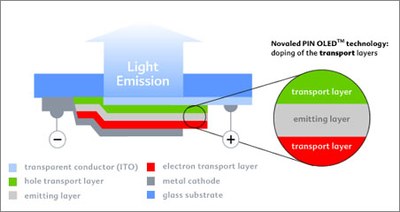Saint-Gobain and Novaled Announce a Breakthrough in Glass Substrates for OLED
Saint-Gobain and Novaled have demonstrated the feasibility of large area OLEDs, based on a new high-performance metallic anode, with Saint-Gobain Recherche technology and Novaled OLED proprietary developments.
The goal of a two-year research cooperation programme between both partners has been to develop basic technologies for high-performance white OLEDs. Researchers at Saint-Gobain Recherche (SGR) have created a highly conductive transparent electrode “Silverduct™”, bringing up to 10 times better surface conductivity than traditional ITO (Indium Tin Oxide). Thanks to Novaled PIN OLED™ technology for high efficiency OLEDs, samples were successfully manufactured on large area surfaces. SGR and Novaled now see the possibility to produce homogeneous OLED devices up to 100 cm² which will ease the manufacturing of large OLED lighting products.
Traditional ITO coated glass impedes the race to large area OLED, due to its limited ability to carry
current over distances longer than a couple of centimetres. Therefore, for large area OLEDs, the ITO layer must be topped with a thick metallic grid to prevent gradient of light emission caused by the sheet resistance of ITO alone (typically 30 Ohm/sq). The new anode Silverduct™ has a sheet resistance of less than 4 Ohm/sq, thus enabling large area OLEDs without additional metal grids. This is an important step especially for transparent and bottom emission OLEDs in which the metal grid is visible. Additionally, by eliminating the metal grid Silverduct™ offers significant potential for reducing manufacturing costs.
“Saint-Gobain has world-class expertise in manufacturing metallic layers on glass. Our researchers
have developed Silverduct™ which is well-suited to the promising OLED market”, says Pr. Didier Roux, VP Research of Saint-Gobain Group. “When combining the remarkable advantages of Novaled PIN OLED™ technology with our specific electrode, we achieved lab samples with an increased efficiency of +30%. The lack of metallic grid makes the whole processing much easier. Furthermore, improved lifetime has been demonstrated, as compared to the equivalent OLED device based on ITO”.
“We have been pleased to work with Saint-Gobain, a global player in the glass industry with innovative metal layers for large lighting areas.” says Gildas Sorin, CEO of Novaled. “This cooperation illustrates our strategy of engaging with the key players to sustain a solid OLED business ramp-up. Our technology offers the advantage of being able to be combined with any substrate surface and electrode structure while providing OLED devices with highest energy saving and longest lifetime” he adds.
About OLEDs:
OLEDs are semiconductors made of thin organic material layers of only a few nanometres thickness. They emit light in a diffuse way to form an area light source. In a fast growing display market OLEDs are key part of a revolution: the dream of paper-thin, highly efficient displays with brilliant colours and great flexibility in design is becoming reality. OLEDs represent the future of a vast array of completely new lighting applications and at the same time offer the potential to become even more efficient than energy-saving bulbs.
About Novaled:
Novaled AG is a world leading company in the OLED (organic light-emitting diode) field specialised in high efficiency long lifetime OLED structures and an expert in synthetic and analytical chemistry. The company offers complete solutions to the organic electronic markets, commercializing its Novaled PIN OLEDTM technology along with its proprietary OLED materials. Novaled has developed long term partnerships with major OLED players worldwide. Based on more than 350 patents granted or pending, Novaled has a strong IP position in OLED technology. Main investors are Crédit Agricole Private Equity, TechnoStart, TechFund Capital Europe and CDC Innovation. www.novaled.com
About Saint Gobain and Saint Gobain Recherche:
As a producer, processor and distributor of materials (glass, ceramics, plastics, cast iron, etc.), Saint-Gobain transforms raw materials into advanced products for use in our daily lives, as well as developing tomorrow’s new materials. Saint-Gobain operates in 54 countries worldwide, is one of the world’s hundred leading industrial corporations, and fields a workforce of over 207,000 people. Saint-Gobain is listed on the stock markets in Paris, London, Frankfort, Zurich, Brussels and Amsterdam.
Saint-Gobain Recherche is a major industrial laboratory working in the field of materials. Its main task is to carry out research for the industrial sectors of the Saint-Gobain Group.



